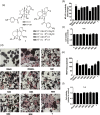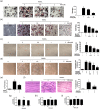A marine fungus-derived nitrobenzoyl sesquiterpenoid suppresses receptor activator of NF-κB ligand-induced osteoclastogenesis and inflammatory bone destruction
- PMID: 32608081
- PMCID: PMC7443469
- DOI: 10.1111/bph.15179
A marine fungus-derived nitrobenzoyl sesquiterpenoid suppresses receptor activator of NF-κB ligand-induced osteoclastogenesis and inflammatory bone destruction
Abstract
Background and purpose: Osteoclasts are unique cells to absorb bone. Targeting osteoclast differentiation is a therapeutic strategy for osteolytic diseases. Natural marine products have already become important sources of new drugs. The naturally occurring nitrobenzoyl sesquiterpenoids first identified from marine fungi in 1998 are bioactive compounds with a special structure, but their pharmacological functions are largely unknown. Here, we investigated six marine fungus-derived nitrobenzoyl sesquiterpenoids on osteoclastogenesis and elucidated the mechanisms.
Experimental approach: Compounds were first tested by RANKL-induced NF-κB luciferase activity and osteoclastic TRAP assay, followed by molecular docking to characterize the structure-activity relationship. The effects and mechanisms of the most potent nitrobenzoyl sesquiterpenoid on RANKL-induced osteoclastogenesis and bone resorption were further evaluated in vitro. Micro-CT and histology analysis were used to assess the prevention of bone destruction by nitrobenzoyl sesquiterpenoids in vivo.
Key results: Nitrobenzoyl sesquiterpenoid 4, with a nitrobenzoyl moiety at C-14 and a hydroxyl group at C-9, was the most active compound on NF-κB activity and osteoclastogenesis. Consequently, nitrobenzoyl sesquiterpenoid 4 exhibited suppression of RANKL-induced osteoclastogenesis and bone resorption from 0.5 μM. It blocked RANKL-induced IκBa phosphorylation, NF-κB p65 and RelB nuclear translocation, NFATc1 activation, reduced DC-STAMP but not c-Fos expression during osteoclastogenesis in vitro. Nitrobenzoyl sesquiterpenoid 4 also ameliorated LPS-induced osteolysis in vivo.
Conclusion and implications: These results highlighted nitrobenzoyl sesquiterpenoid 4 as a novel inhibitor of osteoclast differentiation. This marine-derived sesquiterpenoid is a promising lead compound for the treatment of osteolytic diseases.
Keywords: DC-STAMP; NF-κB; NFATc1; nitrobenzoyl sesquiterpenoids; osteoclast; osteolysis.
© 2020 The British Pharmacological Society.
Conflict of interest statement
The authors declare no conflicts interest.
Figures








Similar articles
-
A Nitrobenzoyl Sesquiterpenoid Insulicolide A Prevents Osteoclast Formation via Suppressing c-Fos-NFATc1 Signaling Pathway.Front Pharmacol. 2022 Jan 17;12:753240. doi: 10.3389/fphar.2021.753240. eCollection 2021. Front Pharmacol. 2022. PMID: 35111044 Free PMC article.
-
Dendrobine attenuates osteoclast differentiation through modulating ROS/NFATc1/ MMP9 pathway and prevents inflammatory bone destruction.Phytomedicine. 2022 Feb;96:153838. doi: 10.1016/j.phymed.2021.153838. Epub 2021 Nov 6. Phytomedicine. 2022. PMID: 34801352
-
Inhibition of RANKL-induced osteoclastogenesis by (-)-DHMEQ, a novel NF-kappaB inhibitor, through downregulation of NFATc1.J Bone Miner Res. 2005 Apr;20(4):653-62. doi: 10.1359/JBMR.041213. Epub 2004 Dec 6. J Bone Miner Res. 2005. PMID: 15765185
-
The Role of TAK1 in RANKL-Induced Osteoclastogenesis.Calcif Tissue Int. 2022 Jul;111(1):1-12. doi: 10.1007/s00223-022-00967-z. Epub 2022 Mar 14. Calcif Tissue Int. 2022. PMID: 35286417 Review.
-
Effects and mechanisms of natural plant active compounds for the treatment of osteoclast-mediated bone destructive diseases.J Drug Target. 2022 Apr;30(4):394-412. doi: 10.1080/1061186X.2021.2013488. Epub 2021 Dec 15. J Drug Target. 2022. PMID: 34859718 Review.
Cited by
-
Sec-O-Glucosylhamaudol Inhibits RANKL-Induced Osteoclastogenesis by Repressing 5-LO and AKT/GSK3β Signaling.Front Immunol. 2022 Apr 26;13:880988. doi: 10.3389/fimmu.2022.880988. eCollection 2022. Front Immunol. 2022. PMID: 35558084 Free PMC article.
-
New 3-Acyl Tetramic Acid Derivatives from the Deep-Sea-Derived Fungus Lecanicillium fusisporum.Mar Drugs. 2022 Apr 6;20(4):255. doi: 10.3390/md20040255. Mar Drugs. 2022. PMID: 35447928 Free PMC article.
-
Marine natural products that inhibit osteoclastogenesis and promote osteoblast differentiation.J Nat Med. 2022 Jun;76(3):575-583. doi: 10.1007/s11418-022-01622-5. Epub 2022 Apr 10. J Nat Med. 2022. PMID: 35397769 Free PMC article. Review.
-
Two New Alkaloids and a New Butenolide Derivative from the Beibu Gulf Sponge-Derived Fungus Penicillium sp. SCSIO 41413.Mar Drugs. 2022 Dec 29;21(1):27. doi: 10.3390/md21010027. Mar Drugs. 2022. PMID: 36662200 Free PMC article.
-
A Nitrobenzoyl Sesquiterpenoid Insulicolide A Prevents Osteoclast Formation via Suppressing c-Fos-NFATc1 Signaling Pathway.Front Pharmacol. 2022 Jan 17;12:753240. doi: 10.3389/fphar.2021.753240. eCollection 2021. Front Pharmacol. 2022. PMID: 35111044 Free PMC article.
References
-
- Alexander, S. P. , Roberts, R. E. , Broughton, B. R. , Sobey, C. G. , George, C. H. , Stanford, S. C. , … Insel, P. A. (2018). Goals and practicalities of immunoblotting and immunohistochemistry: A guide for submission to the British Journal of Pharmacology. British Journal of Pharmacology, 175(3), 407–411. 10.1111/bph.14112 - DOI - PMC - PubMed
-
- Belofsky, G. N. , Jensen, P. R. , Renner, M. K. , & Fenical, W. (1998). New cytotoxic sesquiterpenoid nitrobenzoyl esters from a marine isolate of the fungus Aspergillus versicolor. Tetrahedron, 54(9), 1715–1724. 10.1016/S0040-4020(97)10396-9 - DOI
Publication types
MeSH terms
Substances
Grants and funding
- 81773740/National Natural Science Foundation of China
- 81073119/National Natural Science Foundation of China
- 81741154/National Natural Science Foundation of China
- 201804010027/Guangzhou Science and Technology Plan Project
- 201610010017/Pearl River S&T Nova Program of Guangzhou Scientific Research Project
LinkOut - more resources
Full Text Sources
Research Materials
Miscellaneous

